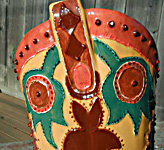Ginna's Quick Guide to Ceramics
Earthenware : Stoneware : Porcelain : Bone China
Earthenware
Earthenware is a common ceramic material used extensively for tableware and decorative objects. All of the bisque used in Ginna's studio is earthenware.
 Although body formulations vary, a generic composition is 25% ball clay, 28% kaolin (Chinese clay),
32% quartz, and 15% feldspar. Earthenware is one of the oldest materials used in pottery. While red, white and buff
colored earthenware clays are commercially available and commonly used.
Although body formulations vary, a generic composition is 25% ball clay, 28% kaolin (Chinese clay),
32% quartz, and 15% feldspar. Earthenware is one of the oldest materials used in pottery. While red, white and buff
colored earthenware clays are commercially available and commonly used.
We generally fire earthenware greenware to Cone 04 (1050C/1920F), at which point it has become vitrified and stable. Now known as "bisque" it can be decorated with paint, slip, and glaze.
We then fire the decorated bisque piece cone 06 (1005C/1850F).
These are the most comming temperatures for us, however the exact temperature of the glaze firing will be influenced by the raw materials used and the desired characteristics of the finished ware. Earthenware is sometimes fired as hot as Cone 2 or 3.
 Finished earthenware is vitrified and opaque, but it has a relatively high porosity, and it will
absorb water. It usually must be glazed in order to be watertight.
Finished earthenware is vitrified and opaque, but it has a relatively high porosity, and it will
absorb water. It usually must be glazed in order to be watertight.
Earthenware may sometimes be as thin as bone china, although it is not translucent and it is much more easily chipped. It is also less strong, less tough, and more porous than stoneware, but it is more economical and easier to work.
Types of earthenware include Creamware, Delftware, Faience, Tin-glazed pottery, Victorian majolica, Raku, and Terra cotta.
[Photos: lifesize ceramic boot by Ginna BB Gordon.
Earthenware bisque, hand decorated with paint,
modeling
slip, and multiple coats of glaze.
]